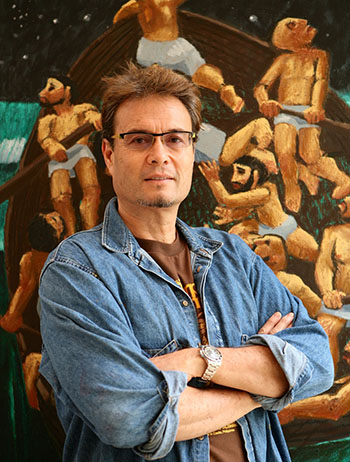 Wayne Forte was born in Manila, Philippines in 1950, married in Brazil in 1981, and studied at the University of California at Santa Barbara and Irvine (B.A. 1973; M.F.A. 1976). Wayne lives with his wife and four children in Laguna Niguel, CA and attends Capo Beach Church, San Juan Capistrano, CA.
Wayne Forte was born in Manila, Philippines in 1950, married in Brazil in 1981, and studied at the University of California at Santa Barbara and Irvine (B.A. 1973; M.F.A. 1976). Wayne lives with his wife and four children in Laguna Niguel, CA and attends Capo Beach Church, San Juan Capistrano, CA.
Wayne has been a member of CIVA (Christians in the Visual Arts) for 25 years and participated in the Florence Portfolio Project in 1993. He has also taught courses at Biola University and Gordon College, Orvieto Campus, Italy.
Full resolution picture: Wayne Forte Picture 7-13.jpg
Artist’s Statement
Raised by a Filipino Catholic Mother and an Irish Catholic Father, my first aesthetic experiences took place at the historic Old Mission in Santa Barbara, California. Throughout my school years the images that touched me most deeply were the more ecstatic of the biblical narratives of Gruenwald, Rubens, Rembrandt and Carravagio. I was later educated to paint in the self-referential Modernist tradition but longed for the passion of an earlier age, a passion for the spiritual and the transcendent.
This longing came closer to becoming reality when in 1978 I received the gift of faith in Christ and began to seriously consider the possibility of becoming a “religious painter.” My first attempts were simply “updates” of Old Master paintings. While these masterpieces once delivered a powerful message about faith, the advance of artistic styles and conventions eventually diminished their power – they looked old-fashioned and their message no longer resonated with contemporary viewers. I wanted to rework them, listen to their story, edit and then build upon what was usable, passing their message on with a fresh voice to a new generation. And although this generation is conditioned by media over-exposure, mesmerized by science and technology and cynical about God, it is the generation that I am a part of and with which I live and communicate (examples: “New World Order (after Massaccio) ’90,” “Susannah and the Elders (after Gentileschi ‘90,” “Jacob and Rachael (after Dyce) ’88”).
Soon I was to try original compositions derived from personal journals which I kept of my own study of the scriptures. These works combined biblical narratives with my own journey of faith, allowing me to place myself into the context of a particular Bible story. As a modern painter, no longer obliged to illustrate the Scriptures for an illiterate audience, I layered and juxtaposed images, text and objects, linking personal history with the Biblical narrative in a stream of consciousness. This process encouraged unexpected associations and surprising viewpoints different from the traditional interpretation of scriptural passages (examples: “Wreath for the Sinai Generation ‘01,” “Why Canaan?…and the Curse Goes On ’97”).
As part of a church “worship team,” I have been required to paint large canvases that will stand up to a large auditorium space. Also art is experienced differently in a liturgical context, where is has a specific function of standing for the values and aspiration of a particular congregation. This requirement can be stifling and produce some rather inert art. For me the challenge was to inject the work with my own personal experience of “Scripture as God’s Living Word.” (examples: “Scarlet Letters ‘01,” “The Reluctant Servant ‘01,” “Enter through Praise ‘92”).
To be a religious painter in a secular age may seem, to many, anachronistic and narrow. Paradoxically, I have found that it satisfies my desire to portray the spiritual while transcending Modernism’s self-centeredness.
From “Stirring the Waters” Show at Westmont College, May 2003
Below you can watch a short documentary film on Wayne Forte’s work and life, produced by his son Tiago Forte.
Connect with me via:
Instagram: @thefortestudios https://instagram.com/thefortestudios?igshid=OGQ5ZDc2ODk2ZA%3D%3D&utm_source=qr
Facebook: Wayne Forte https://www.facebook.com/profile.php?id=61551911165502&mibextid=LQQJ4d
